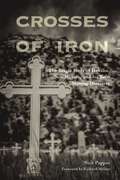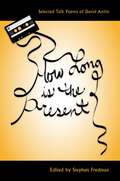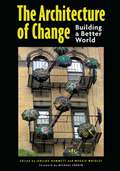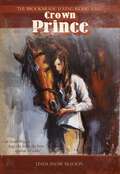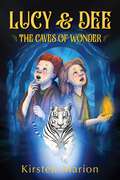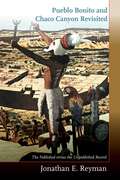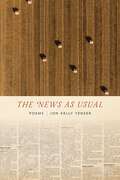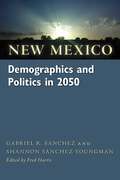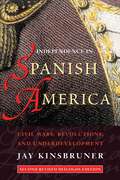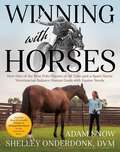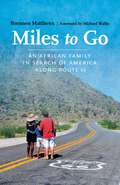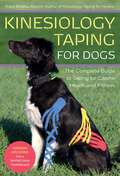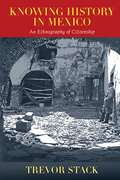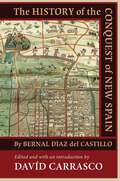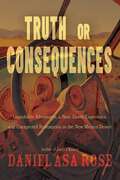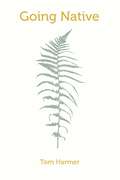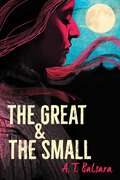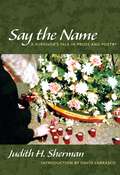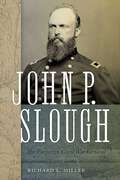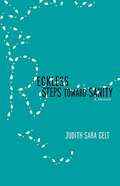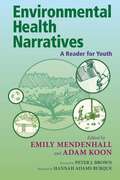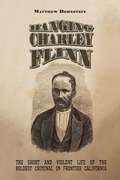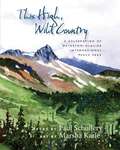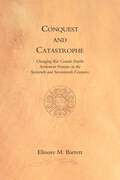- Table View
- List View
Crosses of Iron: The Tragic Story of Dawson, New Mexico, and Its Twin Mining Disasters
by Nick PappasWinner of the Historical Society of New Mexico Gaspar Pérez de Villagrá Award—for outstanding publication in New Mexico or Southwest borderlands history In October 1913, 261 miners and two rescuers died when a massive explosion ripped through a mine operated by Phelps, Dodge & Company in Dawson, New Mexico. Ten years later, a second blast claimed the lives of another 120 miners. Today, Dawson is a deserted ghost town. All that remains is a sea of white iron crosses memorializing the nearly four hundred miners killed in the two explosions—a death toll unmatched by mine disasters in any other town in America. Now, to mark the centennial of the second disaster, veteran journalist Nick Pappas tells the tragic story of what was once New Mexico&’s largest and most modern company town and of how the strong, determined residents of the community coped with two heartbreaking catastrophes.
How Long Is the Present: Selected Talk Poems of David Antin (Recencies Series: Research and Recovery in Twentieth-Century American Poetics)
by David AntinPoet, performance artist, and critic David Antin invented the &“talk poem.&” He insists that his poems be oral and created in front of a live audience, in a specific time and place, with the transcription of the performance adjusted for print by presenting it not in prose but in clumps of words without justified margins or punctuation, peppered with white spaces that indicate pauses.In this book, editor Stephen Fredman provides a critical introduction to a selection of talk poems from three out-of-print collections, accompanied by a new interview with the author. As Fredman points out, Antin&’s work is a form of conceptual writing that has influenced generations of experimental poets and prose writers. His profound and humorous talk poems are essential for classroom and scholarly discussions of the arts in modernism and postmodernism—offering as well an invitation to strengthen the ties between the sciences and the humanities.
The Architecture of Change: Building a Better World
by Jerilou Hammett Maggie WrigleyThe Architecture of Change: Building a Better World is a collection of articles that demonstrates the power of the human spirit to transform the environments in which we live. This inspiring book profiles people who refused to accept that things couldn&’t change, who saw the possibility of making something better, and didn&’t esitate to act.Breaking down the stereotypes surrounding &“socially engaged architecture,&” this book shows who can actually impact the lives of communities. Like Bernard Rudofsky&’s seminal Architecture Without Architects, it explores communal architecture produced not by specialists but by people, drawing on their common lives and experiences, who have a unique insight into their particular needs and environments. These unsung heroes are teachers and artists, immigrants and activists, grandmothers in the projects, students and planners, architects and residents of some of our poorest places. Running through their stories is a constant theme of social justice as an underlying principle of the built environment. This book is about opening one&’s eyes to new ways of interpreting the world, and how to go about changing it.
Crown Prince
by Linda Snow McLoonSarah Wagner has always dreamed of having a horse of her own. When she manages to keep a runaway school horse from hurting himself and others, Sarah captures the attention of the owners of Brookmeade Farm. Suddenly, she finds her dream finally coming true with the gift of the racetrack rogue, Crown Prince, but keeping the beautiful and talented troublemaker proves to be a challenge. Sarah must convince her parents her new horse is safe to ride, and at the same time find a way to keep Crown Prince's former owner from taking him back. This is the story of one girl's determination to keep the horse she loves when the odds are stacked against her.Written for ages 12 and up.
The Caves of Wonder: Lucy & Dee (Book 2) (Lucy & Dee)
by Kirsten MarionTrapped in Sericea, Lucy and Dee continue their adventure with the young emperor Yidi. Together they must travel to the Caves of Wonder to find the White Tiger, a fabled warrior… and their best bet for confronting the evil queen.A deftly crafted and thoroughly fun read ... especially and unreservedly recommended for elementary school, middle school, and community library Fantasy Fiction collections. MBR Midwest Book review
Pueblo Bonito and Chaco Canyon Revisited: The Published versus the Unpublished Record
by Jonathan E. ReymanChaco Canyon and Mesa Verde are arguably the two best-known archaeological areas in the American Southwest. Yet despite more than a century of archaeological research, many questions remain unanswered.From more than fifty years of research, archaeologist Jonathan E. Reyman has uncovered a wealth of materials from the work of George Pepper and Richard Wetherill, mostly from the 1896–1901 Hyde Exploring Expedition at Chaco Canyon but also from later field and collections research at more than twenty institutions in the United States. Previously unpublished Pepper-Wetherill field notes, photographs, and drawings combined with newly commissioned drawings offer a significant revision to what we know about the Chacoan world.Reyman’s research has produced a unique book that compares the published record with the unpublished record to provide new information and insight into the archaeological culture and history of Chaco, the findings of the HEE and other pre-1950 archaeological projects, various Chaco field schools, and much more.Pueblo Bonito and Chaco Canyon Revisited offers a blueprint for future research among existing archaeological collections.
The News as Usual: Poems (Mary Burritt Christiansen Poetry Series)
by Jon Kelly YenserThe News as Usual showcases the work of a gifted poet who employs language at its richest. Yenser captures lyrics and blues, ballads and villanelles, and even a crown of sonnets. Sonically rich and filled with detail, these poems link mortality with fishing, nature with protoplasm—constantly finding ways to explore the inner and outer worlds in ways at once understated and wise.
New Mexico Demographics and Politics in 2050
by Gabriel R. Sánchez Shannon Sánchez-Youngman&“Combining New Mexico&’s Hispanic population with its Native American community makes New Mexico one of the few minority-majority states in the country,&” write Gabriel R. Sánchez and Shannon Sánchez-Youngman in this E-short edition from New Mexico 2050. Here, Sánchez, a nationally recognized political scientist, and Sánchez-Youngman, a political science doctoral student, explore New Mexico&’s unique demography and its impact on politics in the state. This selection is enhanced by an accompanying essay by attorney and activist Pamelya Herndon on African Americans and other minorities in New Mexico.
Independence in Spanish America: Civil Wars, Revolutions, and Underdevelopment. Revised edition. (Diálogos Series)
by Jay KinsbrunerIn overturning Spain's control of the Americas, such great military leaders as Simón Bolívar and José de San Martín unleashed both civil wars and revolutions between 1810 and 1824. Sixteen nations emerged from these violent and cataclysmic wars. The liberators set themselves up to govern the new states they created but quickly failed as rulers. They succumbed, in part, to changes resulting from independence itself-a new political order.Military campaigns directed against Spain split the colonists into royalists and patriots, resulting in a decade of civil wars. The newly formed nations simultaneously embraced capitalism and liberalism, but divisions persisted over the purpose of government and the organization of the economy and society.Clearly laid out in this book is an insightful interpretation of a pivotal era in world history. This new edition, revised and enlarged to take account of recently published studies as well as a rethinking of certain prevailing views, is a compelling reinterpretation of the independence era. The turbulent history of the independence movements is set forth with attention to key figures and their ideologies, regional differences, and the legacy of underdevelopment left by the wars of independence. A superior work of synthesis. . . . Kinsbruner writes in a style which engages the attention of the reader, and scholars as well as students will profit from his book. - John Lynch, Professor Emeritus, University of LondonKinsbruner provides us with a much needed clear, concise interpretation. - Richard W. Slatta, North Carolina State University
Winning with Horses
by DVM Shelley Onderdonk Adam SnowA compelling look at a lifetime of success competing with horses, and what it takes to make sure it is the horse that always wins.Is it possible to be simultaneously passionate about winning in an equestrian sportandabout the welfare of horses?Professional polo player Adam Snow and sport horse veterinarian Shelley Onderdonk answer this undeniably twenty-first-century question with a resounding, &“Yes!&” They have spent a lifetime together, nurturing Adam's astounding career at the top of his sport (he is the last American polo player to achieve the perfect 10-goal handicap) with the artful, conscientious care and training of the equine partners he needed to be the best. And Shelley's twenty-five years as an equine veterinarian have been spent helping sport horses compete at the highest levels in other disciplines, as well
Miles to Go: An African Family in Search of America along Route 66
by Brennen MatthewsMiles to Go is the story of a family from Africa in search of authentic America along the country&’s most famous highway, Route 66. Traveling the scenic byway from Illinois to California, they come across a fascinating assortment of historical landmarks, partake in quirky roadside attractions, and meet more than a few colorful characters.Brennen Matthews, along with his wife and their son, come face-to-face with real America in all of its strange beauty and complicated history as the family explores what many consider to be the pulse of a nation. Their unique perspective on the Main Street of America develops into a true appreciation for what makes America so special. By joining Matthews and his family on their cross-country adventure, readers not only experience firsthand the sights and sounds of the road, but they are also given the opportunity to reflect on American culture and its varied landscapes. Miles to Go is not just a travel story but a tale of hopes, ambitions, and struggles. It is the record of an America as it once was and one that, in some places, still persists.
Kinesiology Taping for Dogs
by Katja Bredlau-MorichDo-it-yourself physical therapy techniques for keeping your dog happy, active, and pain-free-now and for years to come.Kinesiology taping on humans is now commonplace—it is widely used by physical therapists, chiropractors, and personal trainers. The idea behind taping is that it provides incredible support and stabilization of ligaments and tendons while simultaneously stretching and flexing like a &“second skin&” to allow full range of motion. It can also activate or relax muscles, depending on its application.Taping is now also being successfully applied to other animals. Canine and equine physiotherapist Katja Bredlau-Morich, author ofKinesiology Taping for Horses,is a pioneer in bringing the method to the dog world. She believes that dogs can benefit hugely from taping techniques, and even better, dog owners and trainers can learn practical steps to using kinesiology tape themselves. In her terrific guidebook, Bredlau-Morich provides the ultimate reference for understanding both the uses of kinesiology tape and its numerous canine applications. With hundreds of color photographs and step-by-step instructions for the do-it-yourselfer, her book explains the following forms of kinesiology taping:MuscleScarFasciaIn addition, numerous case studies demonstrate how taping can change a dog's life, keeping him a happy, active, pain-free companion for years to come.
Knowing History in Mexico: An Ethnography of Citizenship
by Trevor StackWhile much has been written about national history and citizenship, anthropologist Trevor Stack focuses on the history and citizenship of towns and cities. Basing his inquiry on fieldwork in west Mexican towns near Guadalajara, Stack begins by observing that people talked (and wrote) of their towns&’ history and not just of Mexico&’s.Key to Stack&’s study is the insight that knowing history can give someone public status or authority. It can make someone stand out as a good or eminent citizen. What is it about history that makes this so? What is involved in knowing history and who is good at it? And what do they gain from being eminent citizens, whether of towns or nations?As well as academic historians, Stack interviewed people from all walks of life—bricklayers, priests, teachers, politicians, peasant farmers, lawyers, and migrants. Resisting the idea that history is intrinsically interesting or valuable—that one simply must know the past in order to understand the present—he explores the very idea of &“the past&” and asks why it is valued by so many people.
The History of the Conquest of New Spain by Bernal Díaz del Castillo
by Bernal Díaz del CastilloThe History of the Conquest of New Spain by Bernal Diaz del Castillo, a new abridgement of Diaz del Castillo's classic Historia verdadera de la conquista de Nueva España, offers a unique contribution to our understanding of the political and religious forces that drove the great cultural encounter between Spain and the Americas known as the "conquest of Mexico." Besides containing important passages, scenes, and events excluded from other abridgements, this edition includes eight useful interpretive essays that address indigenous religions and cultural practices, sexuality during the early colonial period, the roles of women in indigenous cultures, and analysis of the political and economic purposes behind Diaz del Castillo's narrative. A series of maps illuminate the routes of the conquistadors, the organization of indigenous settlements, the struggle for the Aztec capital of Tenochtitlan, as well as the disastrous Spanish journey to Honduras. The information compiled for this volume offers increased accessibility to the original text, places it in a wider social and narrative context, and encourages further learning, research, and understanding.
Truth or Consequences: Improbable Adventures, a Near-Death Experience, and Unexpected Redemption in the New Mexico Desert
by Daniel Asa RoseDaniel Asa Rose was a successful novelist, memoirist, book critic, and columnist for the New York Times Magazine, Esquire, and others, when the top blew off his domestic life. His wife of sixteen years wanted out. Before he could slip into depression, doubt, and self-loathing, Dan&’s lifelong friend Tony made an irresistible proposition: go back to the place where, forty years earlier, their college road trip had come to a crashing halt, T-boned by a woman in the decidedly oddball little town of Truth or Consequences, New Mexico.Dan and Tony return to the scene of the crash in an effort to make sense of that fateful moment. He&’s certain that if he can locate the woman in whose arms he almost died, he will find the self he lost and make peace with his life choices since. Dan moves into a single-wide trailer four blocks from the crash. Over the next eight months, inexplicable encounters make him fall in love with the New Mexico desert and the wiggy place that embraces him.Truth or Consequences is a moving true story of hope and redemption. It is a funny, deeply felt rumination on aging, misadventure, and the serendipity of second chances.
The Zeon Files: Art and Design of Historic Route 66 Signs
by Mark C. Childs Ellen D. BabcockIn the mid-twentieth century Eddie&’s Inferno Cocktail Lounge, Bunny Bread, Paris Shoe Shop, and many other businesses throughout New Mexico and the Southwest displayed eye-catching roadside signs created by the Zeon Corporation. These works of commercial art featured unique designs, irregular shapes, dynamic compositions, and neon light. The legendary fiesta dancer at the Albuquerque Terrace drive-in theater, for example, was well-known for the grace of its lines, its enormous size, and its flashing neon skirt. Created during a time before the simplified icons of major chains, many of these culturally significant artworks no longer exist. The Zeon Files rescues these historic artifacts from obscurity, presenting a collection of the working drawings of historic Route 66–era signs. In addition to presenting a visually rich archive, the authors discuss the working methods of design and construction and the craft of drafting techniques during this innovative era of American sign making.
Going Native
by Tom HarmerIn a spiritual autobiography shaped by years of living with a band of Salish Indian people after the Vietnam War, Tom Harmer shares his hard-won knowledge of their world and the nature spirits that govern it. Leaving behind college, military service, and years of living off the land as he drifted aimlessly and smuggled draft dodgers and deserters into Canada, Harmer came to the isolated Okanogan region of Washington state in the company of an Indian man hitchhiking home after Wounded Knee. Harmer was desperate to make something of his life. He settled down for nearly ten years close to his Indian neighbors, adopted their view of the world, and participated in their traditional sweatlodge and spirit contact practices. From his first sight of Chopaka, a mountain sacred to the Okanogan people, Harmer felt at home in this place. He formed close relationships with members of the Okanogan band living on allotments amidst white ranches and orchards, finding work as they did, feeding cattle, irrigating alfalfa, picking apples, and eventually becoming an outreach worker for a rural social services agency. Gradually absorbing the language, traditions, and practical spirit lore as one of the family, he was guided by an elderly uncle through arduous purification rites and fasts to the realization that his life had been influenced and enhanced by a shumíx, or spirit partner, acquired in childhood.
The Great & the Small
by A.T. BalsaraListed in 18 Canadian young adult books to check out in fall 2024 - CBC Books Fall 2024Ananda is a troubled teen who feels like a misfit at home and at her new school, and her unusual ability to connect with animals makes her feel like even more of an outsider. Still raw from the death of her grandmother, Ananda's dreams are haunted by a long-buried memory that causes her to push people away.Fin is a Tunnel rat who lives in the passages beneath the city, in the dark places humans overlook or despise. Orphaned as a pup, he is the nephew of the Tunnel's charismatic leader, the Beloved Chairman, and is willing to do anything to please his uncle, including becoming his lead henchman.The worlds of humans and rats suddenly collide when Ananda protects Fin during a chance encounter in the market. Neither can foresee how their lives will forever be inextricably linked, but as the Chairman launches a plague war against the humans, both Fin and Ananda wrestle with secrets so terrible that they threaten their very existence.Told as mirroring narratives that reverberate with the effects of buried trauma, and informed by historical accounts of plague and dictatorship, this stunning tale examines what it takes to grasp for light in the darkness and survive the threats both beyond us and within us.
Say the Name: A Survivor's Tale in Prose and Poetry
by Judith H. ShermanSay the Name vividly describes in the voice of a fourteen-year-old the experiences of a Jewish girl who was imprisoned in Ravensbruck Concentration Camp during World War II. Miraculously, Judita Sternova of Kurima, Czechoslovakia, survives persecutions, hiding, flight, capture, deportation, and the Camp. Like the few other surviving Jews, she could not bear to remain in her village emptied of family and other Jews and emigrates to England and, eventually, the United States. After more than fifty years Sherman gets up from her years of memories, private resistance, and public silence to write this book. She is triggered to do so upon hearing a lecture by Professor Carrasco at Princeton on Religion and the Terror of History. The narrative is interspersed with Sherman's powerful poems that grab the reader's attention. Poignant original drawings made secretly by imprisoned women of Ravensbruck, at risk of their lives, illuminate the text. Sherman courageously bears witness to the terror of man and simultaneously challenges God for answers. This book should jolt us into remembrance, warning, and action.
John P. Slough: The Forgotten Civil War General
by Richard L. MillerJohn Potts Slough, the Union commander at the Battle of Glorieta Pass, lived a life of relentless pursuit for success that entangled him in the turbulent events of mid-nineteenth-century America. As a politician, Slough fought abolitionists in the Ohio legislature and during Kansas Territory&’s fourth and final constitutional convention. He organized the 1st Colorado Volunteer Infantry after the Civil War broke out, eventually leading his men against Confederate forces at the pivotal engagement at Glorieta Pass. After the war, as chief justice of the New Mexico Territorial Supreme Court, he struggled to reform corrupt courts amid the territory&’s corrosive Reconstruction politics.Slough was known to possess a volcanic temper and an easily wounded pride. These traits not only undermined a promising career but ultimately led to his death at the hands of an aggrieved political enemy who gunned him down in a Santa Fe saloon. Recounting Slough&’s timeless story of rise and fall during America&’s most tumultuous decades, historian Richard L. Miller brings to life this extraordinary figure.
Reckless Steps toward Sanity: A Memoir
by Judith Sara GeltAt sixteen Judith Sara Gelt finally rebels after spending years watching her warm, Jewish home in Denver disintegrate. It&’s 1968 and bipolar disorder has been ravaging her mother and has sent her father, a powerful attorney, into a spiteful tailspin. To escape Gelt makes one perilous choice after another, and these decisions carry her, unprepared and alone, into a world that is sometimes cruel and often dangerous. After returning to Denver she works to understand her parents and her past, and she is surprised to discover her own strengths.Throughout her memoir Gelt reflects upon how risk taking has shaped her relationships with and her attitudes toward men and sex, her daughter, Judaism, and her own eventual diagnosis of major depressive disorder.
Environmental Health Narratives: A Reader for Youth
by Emily Mendenhall Adam KoonAndrew woke up with a guinea worm coming out of his foot as a result of drinking unsafe water a year previously. Anjali awoke with a cough because smoke from kilns filled her dilapidated home.Tyler stayed home from school because he had a stomachache from eating bad beef.What are the links between the environments in which these young people live and their health problems? The stories, most set in poor communities, draw attention to the effects of air, water, food, climate, urbanization, and other human impacts on health. A comprehensive teaching guide provides a context from which readers can explore problems and solutions in environmental health.
Hanging Charley Flinn: The Short and Violent Life of the Boldest Criminal in Frontier California
by Matthew S. BernsteinCharley Flinn, otherwise known as &“Mortimer,&” was the craftiest criminal in frontier California. Upon his release from San Quentin State Prison in 1863, Mortimer quickly made up for lost time. He formed a gang of robbers in Virginia City, led a prison break in Northern California, and became the most wanted man in the Bay Area. Boldly outwitting both the police and the press, including the young investigative reporter Mark Twain, Mortimer escalated to wilder and wilder heists. But when he fell for a devious femme fatale, Mortimer&’s crimes took a darker turn.Matthew Bernstein paints the Old West in all its terrible glory, where desperadoes tangle with crooked detectives, bloodthirsty posses, and sultry seductresses. Throughout it all, Charley Flinn keeps up a breakneck speed, committing hundreds of crimes before his love for a treacherous woman and his own violent nature lead him to a fitting climax.
This High, Wild Country: A Celebration of Waterton-Glacier International Peace Park
by Paul SchulleryFor centuries, the spectacular landscapes now protected in Waterton-Glacier International Peace Park have amazed and inspired us. Historian-naturalist Paul Schullery and artist-illustrator Marsha Karle bring us a new and richly textured portrait of this magnificent region and reveal why Waterton-Glacier is a world treasure.Through Schullery's text and Karle's watercolors and drawings, we crisscross the roads and trails of this magnificent wilderness. We learn its deep geological history and encounter its wild residents. And we discover its ever-increasing value as a barometer of planetary health in today's rapidly changing world.Schullery, who has been described as the foremost citizen of the American national parks, and Karle, whose art is informed by a National Park Service career in some of North America's most beautiful landscapes, combine their talents to create a memorable tale of the beauty, power, and peril of this high, wild country.
Conquest and Catastrophe: Changing Rio Grande Pueblo Settlement Patterns in the Sixteenth and Seventeenth Centuries
by Elinore M. BarrettThis book forces a rethinking of our understanding of the Pueblo Indians of New Mexico between the beginning of Spanish exploration in 1540 and the aftermath of revolt and reconquest at the end of the 1600s. Specifically, Pueblo losses of settlements and population are reinterpreted in a masterful synthesis of history, archaeology, and human geography, including discussion of the natural environment based on paleoclimate reconstructions. Barrett shows that the greatest loss of Pueblo settlements occurred in the 1630s when 51 percent of the Rio Grande pueblos were abandoned in the wake of Spanish colonization and mission building that began in 1600. Between 1600 and the revolt of 1680 the number dropped by 62 percent, from 81 to 31 pueblos.By providing the first multifaceted and holistic account of Pueblo settlements in the Rio Grande region over a period of 160 years, Barrett offers a new perspective on the dynamics of Pueblo-Spanish interactions. Spanish exploitation and disruption of the Pueblo economy, Apachean raids, and the impact of droughts are re-assessed. But a major epidemic from 1636-40 likely proved the most crucial factor in the reduction of Pueblo population and settlements. Moreover, the gradual realization of the extent of their losses and grasping what it would mean for their continued existence was probably the most important factor, more than religious or civil persecution, in galvanizing the Pueblo peoples to achieve the unprecedented unity that made possible their successful uprising in 1680. They were unable to sustain this unity when the Spanish returned in 1692 and suffered further losses of pueblos, population, and territory as a result of the reconquest.No serious future work on the Pueblos can be undertaken without reference to this one. The text, simply put, clarifies the entire framework of early Spanish-Indian relations.--Marc Simmons
